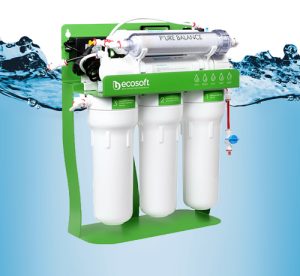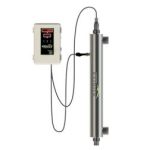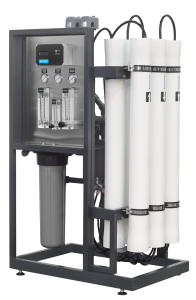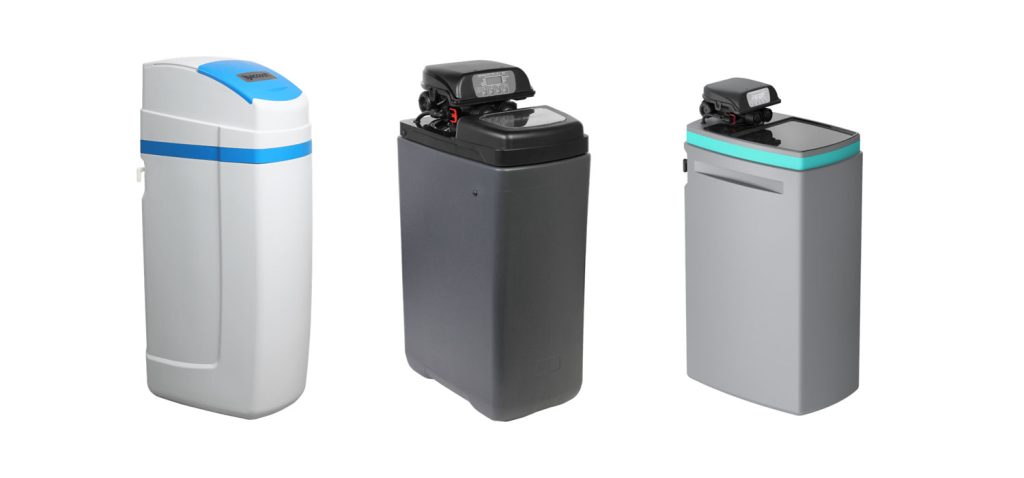FAQ’S
FAQ's
Here you’ll find answers to the general questions we get asked the most about about water filtration
Water filter is a general term but essentially can be categorised as a filter that removes unwanted impurities which improve the taste and quality of the water.
Mains water is treated to an industry standard, so while it is safe to drink you may want to use a filter to improve the taste, odour and add some safety against cryptosporidium or heavy metals.
A “point of use” filter, installed just before a drinking water tap is the most common. These can range from simple sediment filters, carbon blocks (commonly called CTO filters, “chlorine, taste and odours”), Doulton ceramic filters through to small domestic Reverse Osmosis units.
A “point of entry” filter, installed as the water enters the property, treats all the water and are therefore physically bigger, but can provide the same function as point of use filters.
Also see our FAQs regarding water softeners.
Private water supplies, such as boreholes will need at least a 5 micron sediment filter used in conjunction with a UV.
Also see our FAQs regarding boreholes.
Depending on your water source a range of contaminants, chemicals or minerals may be present.
Mains water in the UK is usually considered safe to drink; our utility companies spend millions of pounds per year to ensure this. Mains water can contain minerals such as Magnesium and Calcium. It will also have been chemically treated in order to kill bacteria and microorganisms and may therefore also contain chemicals such as chlorine or chloramines.
Borehole water on the other hand has had no treatment apart from the natural filtration process so may not be safe to drink, and may also contain suspended particles, dissolved minerals and a very wide range of other contaminants which you may need or prefer to remove.
Consequently J&F Water Treatment always recommends that a water analysis be obtained. Such a water analysis should particularly look for the levels or presence of iron, manganese, nitrates, bacteria, hardness, turbidity and Ph.
Get in touch to find out more
Put simply hard water contains dissolved compounds, such as calcium carbonate and magnesium carbonate. As rain water is slightly acidic it breaks down and absorbs minerals in the rock through which it filters. These rocks vary depending on region. This then determines the hardness of the water and the water can be treated accordingly depending on how it is to be used.
Hard water forms lime-scale forming unsightly deposits on taps, sinks, shower screens etc and also effects the efficiency (and lifespan) of appliances such as boilers and kettles. hard water does not “soap” as easily as soft or softened water meaning that more soap (and other cleaning products) will need to be used. Clothes will also feel hard and rough when washed.
The “hardness” of water can range from “slight” to “very hard”. It is not damaging to your health and can actually improve the taste of water due to the essential minerals it contains. (You may have noticed how a cup of tea can taste different depending on where you are in the country!)
Softened water on the other hand can save industry and households significant amounts of money over using hard water.
Get in touch to find out more
Iron is the most abundant & common element (by mass) on earth. When present in a borehole or water well supply it can cause very unsightly brown/orange/red stains. Iron can also prevent an Ultra Violet disinfection system from working correctly. J&F have different solutions for the removal of Iron.
Get in touch now to speak to one of our team.
Activated carbon is carbon that has been treated with steam to a high temperature and is used for the removal or reduction of organic compounds by a process called adsorption. It can be produced from coconut shell, wood, bituminous coal or lignite coal. J&F only specify coconut shell based carbons as they are produced from a renewable source.
The removal of chlorine from drinking water to improve the taste can be achieved by either granular activated carbon filters or carbon block filters. Carbon block filters are more efficient than the loose granular form, due to the specific manufacturing technique, they are denser and therefore contain more carbon allowing the block form to adsorb more chlorine.
Different grades such as “catalytic” carbon will remove chloramines and hydrogen sulphide, whilst one of the primary functions of “acid washed” carbon is pre and post treatment for commercial RO systems.
Cryptosporidium is a microscopic parasite that can cause Cryptosporidiosis which is a gastrointestinal infection causing sickness and diarrhoea in humans and animals. Cryptosporidium can be found in water sources that have come into contact with infected sewage and animal waste.
Whilst boiling water can provide a short term solution for cryptosporidium, a longer term solution is the installation of a Luminor Ultra Violet system.
Get in touch to speak to one of our highly trained team today.
A rotten egg smell indicates that hydrogen sulphide gas (H2S) is present in the water supply. This can be caused by decaying organic matter or sulphate reducing bacteria and is usually present in association with iron.
Whilst a low level of hydrogen sulphide is not harmful, it does make the water smell and can be corrosive.
We can remove hydrogen sulphide by using catalytic carbon and oxygen diffusion.
Ultraviolet water treatment is a simple and effective process proven to be 99% efficient in stopping the spread of bacteria and viruses in tap and spring water without the addition of chemicals
A special bulb is used to allow a high-powered form of invisible ultraviolet light (UV-C) reach and penetrate the microorganisms, disrupting their DNA and disabling them from replicating.
Further water treatment may still be required to treat other contaminants.
Get in touch to find out more.
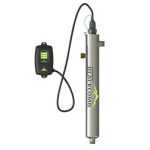
UV Intensity (UVI) measures the brightness of the UV light reflecting off the interior of the stainless steel wall of the chamber. The UV sensor measures how much light passes through the water and generates a percentage on the Luminor controller screen of how much light is being reflected.
UV Transmittance (UVT) is not the same as UV Intensity. UVT is a water quality parameter that determines how much light passes through the water compared to the amount of light that passes through a pure water sample.
Some things that influence the UV Intensity and the readings generated by the Luminor UV sensor are:
– The output from the UV lamp
– Fouling / dirty quartz sleeve and/or sensor
– UV Transmittance of the water
You can have a brand new lamp, quartz sleeve and sensor BUT if the UVT of the water is low it will cause a system fitted with a sensor to emit a low UV alarm – on the other hand if the UVT is high but the quartz sleeve or sensor are fouled this will also cause a low UV alarm.
Coliform bacteria are always found in the digestive system of animals and humans and can also be present in faeces, raw sewage water, decaying plants and soil. Whilst most coliform bacteria do not cause disease they should not be confused with E.coli or fecal coliforms which can cause serious diseases.
By testing the water for coliform bacteria you are getting an indication that your water may be contaminated. Rather than testing for each individual strain of bacteria, as this is a timely and costly process, we look at how high the coliform count is. The higher the count the more likely it is that your water contains a potentially dangerous bacteria which can cause a range of health problems including vomiting and diarrhoea.
The water can be treated by boiling before use but this is not at all practical if using the water source regularly or if a large volume of water is required.
For a permanent solution we would recommend UV (ultraviolet) filtration which is proven and efficient in killing bacteria in tap and spring water without the addition of chemicals. As an example, E.coli requires a UV dose of 6mJ/cm<sup>2</sup> for a 4-log or 99.9% kill. We typically size our UV systems based on a 30mJ/cm2 dose and typical water waterborne pathogens will be eradicated at half of this dose.
Get in touch today and we will help you decide which type of filter you may need.
Reverse Osmosis is a filtration system which uses a semi-permeable membrane to remove dissolved solids from water.
Reverse Osmosis can remove such contaminants as lead, fluorides, chlorides, sodium and sulphates. A 5 stage RO system typically removes these types of “salts”, a 6 stage RO system also removes them but a final filter adds back essential minerals such as calcium and magnesium which improve the taste of water.
We also build larger commercial reverse osmosis systems for industry. For example poultry, fruit growing, distilleries and breweries.
Take a look at our case studies section to find out about the systems we have provided or get in touch now to speak to one of our highly trained team.
A water softener works by a process called ion exchange. This process exchanges magnesium and calcium ions, which form limescale, for sodium ions.
A common misconception is that this process of adding sodium will make your water taste salty. This is not true. Only Sodium ions are exchanged, as opposed to sodium chloride (which is common salt). Therefore, the water does not taste “salty” and the sodium content of the water is also very low. (There’s 122mg of Sodium in a single slice of white bread compared to 37mg in a litre of softened water).
A mineral tank makes up the main part of the softener containing the ion-exchange resin. Water enters and leaves the tank through a valve which controls the softening process. Once the resin has become exhausted a brine solution (water and common salt) is flushed through the tank which reverses the process and allows the resin to soften the water again.
The control valve can operate on either a time basis or a meter controlled basis, which is more efficient and uses less salt.
Get in touch to find out more.
Whilst livestock may have a better tolerance for poorer quality water there are still many factors that can affect performance which in turn can cause a financial loss.
Poor quality drinking water may cause the livestock to drink less than they need, or even not drink at all, affecting their general health.
In the case of poultry, for example, by supplying water with a sodium content below 50 ppm gives the poultry better growth and improved egg laying quotas.
Water of consistent quality allows farmers to provide “feed” of a consistent nature.
Removing iron, manganese and hardness will also make heat exchangers more efficient and prolong the service life.
Get in touch to speak to one of our team today or check out our case studies section here.
J&F always recommend that an Ultra Violet disinfection system be installed to any form of Private Water Supply including boreholes.
Borehole water is drawn from an underground store of water, known as an aquifer, and is made up from rain water filtered through natural rock formations. A water analysis will show any contaminants that may need to be removed to provide a wholesome water supply.
Speak to one of our highly trained team today.
J&F Water Treatment supplies a complete range of water treatment systems across the UK and Ireland. This includes filtration units, water softeners, reverse osmosis systems, dosing stations, and more — all designed to improve water quality for domestic, commercial, and industrial applications.

